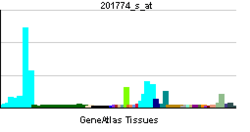NCAPD2
Condensin complex subunit 1 also known as chromosome-associated protein D2 (CAP-D2) or non-SMC condensin I complex subunit D2 (NCAPD2) or XCAP-D2 homolog is a protein that in humans is encoded by the NCAPD2 gene.[1][2][3] CAP-D2 is a subunit of condensin I, a large protein complex involved in chromosome condensation.
References
- ↑ Nagase T, Seki N, Tanaka A, Ishikawa K, Nomura N (Mar 1996). "Prediction of the coding sequences of unidentified human genes. IV. The coding sequences of 40 new genes (KIAA0121-KIAA0160) deduced by analysis of cDNA clones from human cell line KG-1". DNA Res 2 (4): 167–74, 199–210. doi:10.1093/dnares/2.4.167. PMID 8590280.
- ↑ Schmiesing JA, Gregson HC, Zhou S, Yokomori K (Sep 2000). "A human condensin complex containing hCAP-C-hCAP-E and CNAP1, a homolog of Xenopus XCAP-D2, colocalizes with phosphorylated histone H3 during the early stage of mitotic chromosome condensation". Mol Cell Biol 20 (18): 6996–7006. doi:10.1128/MCB.20.18.6996-7006.2000. PMC 88774. PMID 10958694.
- ↑ "Entrez Gene: NCAPD2 non-SMC condensin I complex, subunit D2".
Further reading
- Simon MA (1999). "Racial, ethnic, and gender diversity and the resident operative experience. How can the Academic Orthopaedic Society shape the future of orthopaedic surgery?". Clin. Orthop. Relat. Res. (360): 253–9. PMID 10101332.
- Collas P, Le Guellec K, Taskén K (2000). "The A-kinase-anchoring protein AKAP95 is a multivalent protein with a key role in chromatin condensation at mitosis.". J. Cell Biol. 147 (6): 1167–80. doi:10.1083/jcb.147.6.1167. PMC 2168084. PMID 10601332.
- Kimura K, Cuvier O, Hirano T (2001). "Chromosome condensation by a human condensin complex in Xenopus egg extracts.". J. Biol. Chem. 276 (8): 5417–20. doi:10.1074/jbc.C000873200. PMID 11136719.
- Ball AR, Schmiesing JA, Zhou C et al. (2002). "Identification of a chromosome-targeting domain in the human condensin subunit CNAP1/hCAP-D2/Eg7.". Mol. Cell. Biol. 22 (16): 5769–81. doi:10.1128/MCB.22.16.5769-5781.2002. PMC 133980. PMID 12138188.
- Strausberg RL, Feingold EA, Grouse LH et al. (2003). "Generation and initial analysis of more than 15,000 full-length human and mouse cDNA sequences.". Proc. Natl. Acad. Sci. U.S.A. 99 (26): 16899–903. doi:10.1073/pnas.242603899. PMC 139241. PMID 12477932.
- Ota T, Suzuki Y, Nishikawa T et al. (2004). "Complete sequencing and characterization of 21,243 full-length human cDNAs.". Nat. Genet. 36 (1): 40–5. doi:10.1038/ng1285. PMID 14702039.
- Gerhard DS, Wagner L, Feingold EA et al. (2004). "The status, quality, and expansion of the NIH full-length cDNA project: the Mammalian Gene Collection (MGC).". Genome Res. 14 (10B): 2121–7. doi:10.1101/gr.2596504. PMC 528928. PMID 15489334.
- Nousiainen M, Silljé HH, Sauer G et al. (2006). "Phosphoproteome analysis of the human mitotic spindle.". Proc. Natl. Acad. Sci. U.S.A. 103 (14): 5391–6. doi:10.1073/pnas.0507066103. PMC 1459365. PMID 16565220.
- Beausoleil SA, Villén J, Gerber SA et al. (2006). "A probability-based approach for high-throughput protein phosphorylation analysis and site localization.". Nat. Biotechnol. 24 (10): 1285–92. doi:10.1038/nbt1240. PMID 16964243.
- Olsen JV, Blagoev B, Gnad F et al. (2006). "Global, in vivo, and site-specific phosphorylation dynamics in signaling networks.". Cell 127 (3): 635–48. doi:10.1016/j.cell.2006.09.026. PMID 17081983.
|
|---|
| Envelope (membrane)/
nuclear lamina | |
|---|
| | Nucleolus | |
|---|
| | Other | |
|---|
| see also nucleus diseases
Index of cells |
|---|
| | Description |
- Structure
- Organelles
- peroxisome
- cytoskeleton
- centrosome
- epithelia
- cilia
- mitochondria
- Membranes
- Membrane transport
- ion channels
- vesicular transport
- solute carrier
- ABC transporters
- ATPase
- oxidoreduction-driven
|
|---|
| | Disease |
- Structural
- peroxisome
- cytoskeleton
- cilia
- mitochondria
- nucleus
- scleroprotein
- Membrane
- channelopathy
- solute carrier
- ATPase
- ABC transporters
- other
- extracellular ligands
- cell surface receptors
- intracellular signalling
- Vesicular transport
- Pore-forming toxins
|
|---|
|
|
